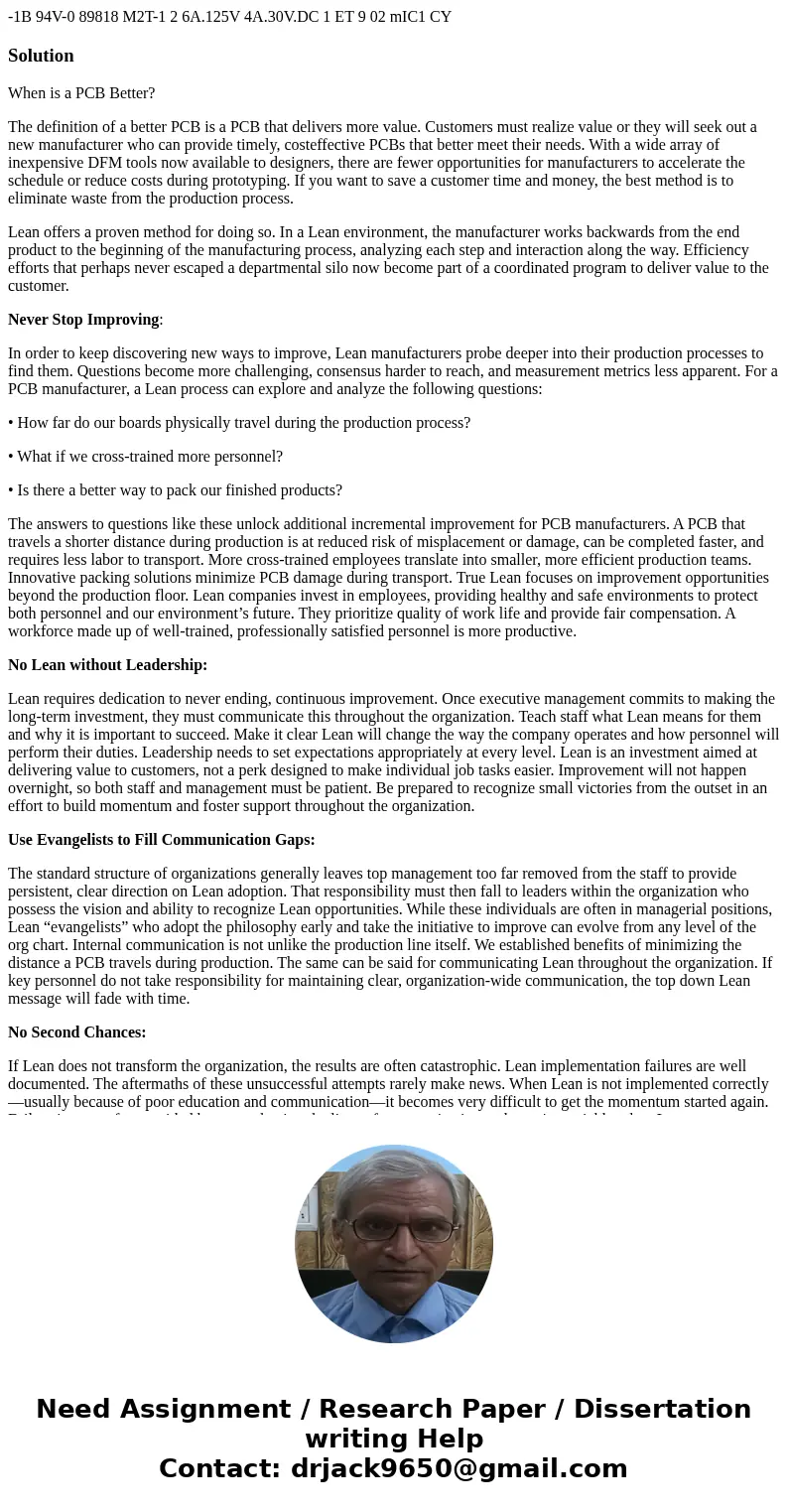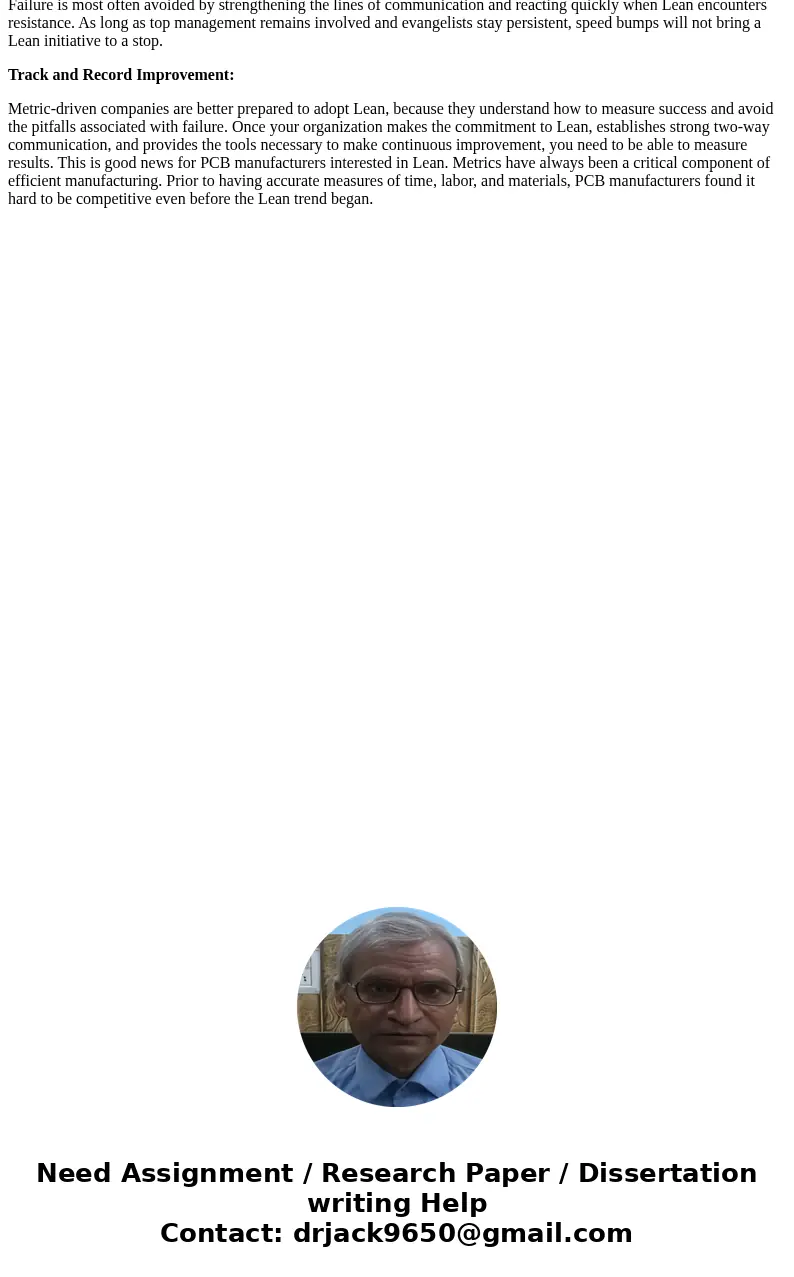1B 94V0 89818 M2T1 2 6A125V 4A30VDC 1 ET 9 02 mIC1 CY Soluti
Solution
When is a PCB Better?
The definition of a better PCB is a PCB that delivers more value. Customers must realize value or they will seek out a new manufacturer who can provide timely, costeffective PCBs that better meet their needs. With a wide array of inexpensive DFM tools now available to designers, there are fewer opportunities for manufacturers to accelerate the schedule or reduce costs during prototyping. If you want to save a customer time and money, the best method is to eliminate waste from the production process.
Lean offers a proven method for doing so. In a Lean environment, the manufacturer works backwards from the end product to the beginning of the manufacturing process, analyzing each step and interaction along the way. Efficiency efforts that perhaps never escaped a departmental silo now become part of a coordinated program to deliver value to the customer.
Never Stop Improving:
In order to keep discovering new ways to improve, Lean manufacturers probe deeper into their production processes to find them. Questions become more challenging, consensus harder to reach, and measurement metrics less apparent. For a PCB manufacturer, a Lean process can explore and analyze the following questions:
• How far do our boards physically travel during the production process?
• What if we cross-trained more personnel?
• Is there a better way to pack our finished products?
The answers to questions like these unlock additional incremental improvement for PCB manufacturers. A PCB that travels a shorter distance during production is at reduced risk of misplacement or damage, can be completed faster, and requires less labor to transport. More cross-trained employees translate into smaller, more efficient production teams. Innovative packing solutions minimize PCB damage during transport. True Lean focuses on improvement opportunities beyond the production floor. Lean companies invest in employees, providing healthy and safe environments to protect both personnel and our environment’s future. They prioritize quality of work life and provide fair compensation. A workforce made up of well-trained, professionally satisfied personnel is more productive.
No Lean without Leadership:
Lean requires dedication to never ending, continuous improvement. Once executive management commits to making the long-term investment, they must communicate this throughout the organization. Teach staff what Lean means for them and why it is important to succeed. Make it clear Lean will change the way the company operates and how personnel will perform their duties. Leadership needs to set expectations appropriately at every level. Lean is an investment aimed at delivering value to customers, not a perk designed to make individual job tasks easier. Improvement will not happen overnight, so both staff and management must be patient. Be prepared to recognize small victories from the outset in an effort to build momentum and foster support throughout the organization.
Use Evangelists to Fill Communication Gaps:
The standard structure of organizations generally leaves top management too far removed from the staff to provide persistent, clear direction on Lean adoption. That responsibility must then fall to leaders within the organization who possess the vision and ability to recognize Lean opportunities. While these individuals are often in managerial positions, Lean “evangelists” who adopt the philosophy early and take the initiative to improve can evolve from any level of the org chart. Internal communication is not unlike the production line itself. We established benefits of minimizing the distance a PCB travels during production. The same can be said for communicating Lean throughout the organization. If key personnel do not take responsibility for maintaining clear, organization-wide communication, the top down Lean message will fade with time.
No Second Chances:
If Lean does not transform the organization, the results are often catastrophic. Lean implementation failures are well documented. The aftermaths of these unsuccessful attempts rarely make news. When Lean is not implemented correctly—usually because of poor education and communication—it becomes very difficult to get the momentum started again. Failure is most often avoided by strengthening the lines of communication and reacting quickly when Lean encounters resistance. As long as top management remains involved and evangelists stay persistent, speed bumps will not bring a Lean initiative to a stop.
Track and Record Improvement:
Metric-driven companies are better prepared to adopt Lean, because they understand how to measure success and avoid the pitfalls associated with failure. Once your organization makes the commitment to Lean, establishes strong two-way communication, and provides the tools necessary to make continuous improvement, you need to be able to measure results. This is good news for PCB manufacturers interested in Lean. Metrics have always been a critical component of efficient manufacturing. Prior to having accurate measures of time, labor, and materials, PCB manufacturers found it hard to be competitive even before the Lean trend began.


 Homework Sourse
Homework Sourse